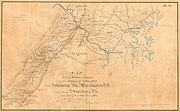Jedediah Hotchkiss
From Wikipedia
Jedediah Hotchkiss (November 30, 1828 – January 17, 1899), also known as Jed, was an educator and the most famous topographer of the American Civil War. His detailed and accurate maps of the Shenandoah Valley are credited by many as a principal factor in Confederate General Stonewall Jackson's victories in the Valley Campaign of 1862.
Early life
Hotchkiss was born in Windsor, New York. He graduated from the Windsor Academy and, by the age of 18, he was teaching school himself in Lykens Valley, Pennsylvania. The following year he relocated to the Shenandoah Valley and opened the Mossy Creek Academy in Augusta County. He supplemented his income as a schoolteacher by working as a mining geologist. As he explored the beautiful area around his new home he began his hobby (and minor business) of mapmaking that would dominate the rest of his life. In 1853 he married a woman from Pennsylvania named Sara Ann Comfort and together they had two daughters. In 1855 Hotchkiss and his brother Nelson founded the Loch Willow Academy school for boys in Churchville, Virginia.
Civil War
In 1861, after the start of the Civil War, Hotchkiss offered his services as a mapmaker to Brig. Gen. Richard B. Garnett, whose Confederate brigade was operating in western Virginia. Hotchkiss served at Rich Mountain and created maps for General Robert E. Lee's planned campaign in the mountains. He took a brief medical leave after being stricken with typhoid fever, but returned to duty in March 1862 as a captain and chief topographical engineer of the Valley District, reporting to Maj. Gen. Stonewall Jackson.

Captain Hotchkiss served under Jackson for the rest of the general's life. Producing large volumes of accurate, detailed, and even beautiful maps, he also aided the general by personally directing troop movements across the terrain with which he had become so familiar. Jackson's reputation for lightning movements and surprise attacks, befuddling his enemies, owes much to Hotchkiss's cartography. Together they served in the Valley Campaign, the Northern Virginia Campaign (including Cedar Mountain, the Second Battle of Bull Run, and Chantilly), the Maryland Campaign (including Harpers Ferry and Antietam), and the Battle of Fredericksburg. At the Battle of Chancellorsville in May of 1863, Hotchkiss discovered the route that Jackson took in his famous flanking march against the Union army. That night, Jackson was mortally wounded and died less than two weeks later.
After his general's death, Hotchkiss continued to be assigned to the staff of the Corps commanders who succeeded Jackson (Generals Richard S. Ewell and Jubal A. Early), but he was frequently called upon to work directly for General Robert E. Lee at the headquarters of the Army of Northern Virginia. Balancing these dual responsibilities, he served through the Gettysburg Campaign, the Mine Run Campaign, and the Overland Campaign. In June 1864 he accompanied General Early on his raid through the Shenandoah Valley toward Washington, D.C., and one of his maps contributed to Early's successful surprise attack against General Philip Sheridan at the Battle of Cedar Creek (although the map was not able to prevent Early's decisive defeat by the end of the battle). He then returned to the Siege of Petersburg with the remnants of Early's defeated army for the remainder of the war.
After General Lee's surrender at Appomattox Court House in April 1865, Hotchkiss, now a major, surrendered to the Union Army. General Ulysses S. Grant had Hotchkiss released from custody and returned his maps to him. Grant paid Hotchkiss for permission to use some of his maps in his reports and almost all of the Confederate maps in the Official Records produced by the U.S. War Department were those drawn by him.
Postbellum
As a civilian again, Hotchkiss moved to Staunton, Virginia, and was involved in economic activities designed to promote the recovery of the war-ravaged Shenandoah Valley and in veterans' affairs. After teaching school, he opened an office as a civil and mining consulting engineer and, being so familiar with the geography of the state, was able to steer lucrative foreign and Northern investments to the most appropriate places.
Hotchkiss collaborated in the writing of the 12-volume Confederate Military History, writing the 1,295-page Virginia volume himself. His journals were edited in 1973 by Archie P. MacDonald and published under the title Make Me a Map of the Valley: The Civil War Journal of Stonewall Jackson's Cartographer. Hotchkiss's sketchbooks, diaries, and maps are available at the Library of Congress in Washington, D.C.
Jedediah Hotchkiss died at his home in Staunton at age 71. He is buried there in Thornrose Cemetery.



